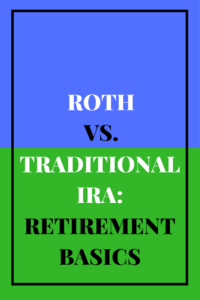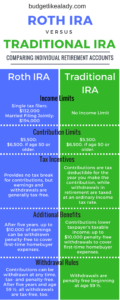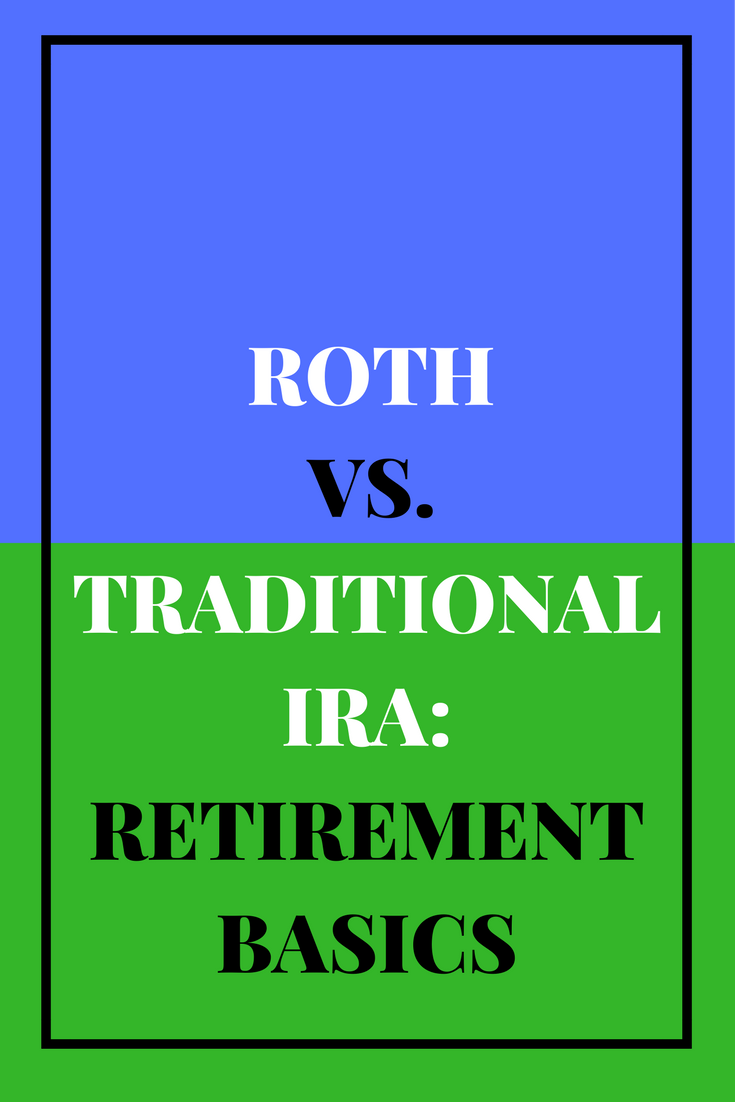Roth vs Traditional IRA: Retirement Basics

3 Surprising Habits That Waste Money
January 12, 2017
How to Raise Your Credit Score like a Boss
January 19, 2017
Often, I get questions about retirement and retirement accounts. The most popular question I receive is, “Roth vs Traditional IRA, which is best for me?” Although the answer to that question depends on the person, I have put together this post and a chart to help people decide.
What is an IRA?
An IRA is an Individual Retirement Account. These retirement accounts are specifically designed to help you save for your retirement and offer tax advantages. Do not confuse an IRA with a 401(k) that you would sign up for at work. IRA’s are set up through a bank or other financial institution by you, not your place of employment.
Unfortunately, you may not be eligible to contribute to a Roth IRA, Traditional IRA, or both. Eligibility restrictions include income and employment status. Before looking at IRA’s, I strongly recommend that you are maxing out your matching on your company’s 401(k). You don’t want to give up free money.
Roth vs Traditional IRA
Income Limits
Roth IRA: Single tax filers must have taxable income of less than $132,000 in 2016, contribution limits are phased out starting at $117,000 per IRS guidelines. Married couples filing jointly must have taxable income of less than $194,000 in 2016, contribution limits are phased out starting at $184,000.
Traditional IRA: No income limit.
Contribution Limits
Roth IRA: $5,500; $6,500, if age 50 or older.
Traditional IRA: $5,500; $6,500, if age 50 or older.
Tax Incentives
Roth IRA: provide no tax break for contributions, but earnings and withdrawals are generally tax-free.
Traditional IRA: contributions are tax deductible on both state and federal tax returns for the year you make the contribution, while withdrawals in retirement are taxed at a regular income tax rate.
In short: with traditional IRAs, you avoid taxes when you put the money in. With Roth IRAs, you avoid taxes when you take it out in retirement.
Additional Benefits
Roth IRA: After five years, up to $10,000 of earnings can be withdrawn penalty-free to cover first-time homebuyer expenses.
Traditional IRA: Contributions lower taxpayer’s taxable income, potentially qualifying them for other tax incentives; up to $10,000 penalty-free withdrawals to cover first-time homebuyer expenses, but taxes due on distributions.
Withdrawal Rules
Roth IRA: Contributions can be withdrawn at any time, tax-free and penalty free. After five years and age 59 ½, all withdrawals are tax-free, too.
Traditional IRA: Withdrawals are penalty free beginning at age 59 ½. Distributions must begin at age 70 ½.

How to Open an IRA
An IRA can be open at almost any bank. There are also many creditable financial institutions that can be found online. For my family, we have signed up with Vanguard for many of our investment account needs including IRA’s (not an affiliate).
As always, I recommend you talk with your financial advisor to understand the best solution for your family’s needs.
Have you thought about investing in an IRA?
Proverbs 13:16 A wise man thinks ahead; a fool doesn’t, and even brags about it!

